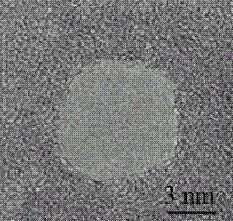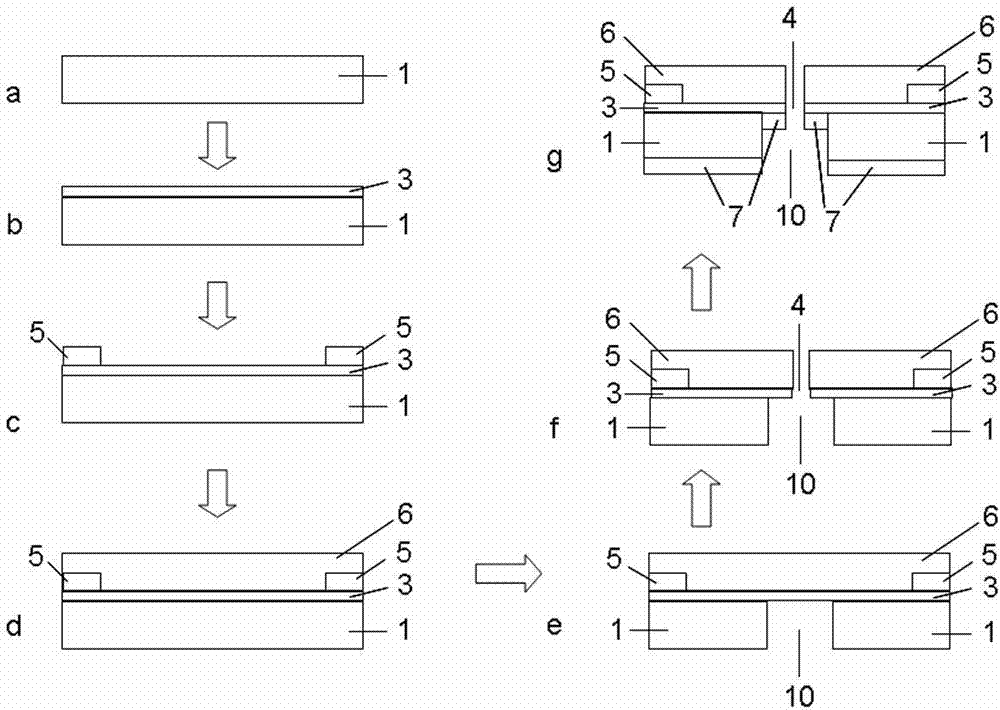Nanopore electrical sensor
A nanopore and sensor technology, applied in the field of sensors, to achieve the effect of avoiding pollution, simple method and firm structure
- Summary
- Abstract
- Description
- Claims
- Application Information
AI Technical Summary
Problems solved by technology
Method used
Image
Examples
Embodiment 1
[0031] Graphene film was synthesized on Cu by chemical vapor deposition method: the surface of Cu sheet with a thickness of 25 μm was polished and cleaned, and then placed in an ultra-high vacuum (1.0×10 -9 torr) heat treatment at 900°C for 30 minutes; 2 h 4 The gas (10 Pa) was grown for 10 minutes; finally, the temperature was rapidly cooled to room temperature, so that a graphene film was obtained on the Cu sheet.
[0032] like figure 1 Shown: 50 nm SiO was sequentially fabricated on a 600 μm thick monocrystalline Si substrate 1 2 and 30 nm Si 3 N 4 Composite insulating layer 2 ( figure 1 a).
[0033] Using photolithography technology, and using KOH solution and buffered HF solution to etch the silicon substrate and SiO 2 And prepare a square opening 10 ( figure 1 b).
[0034] E-beam etching with SF 6 A hole 11 ( figure 1 c).
[0035] The prepared graphene film is transferred to the silicon nitride film as the nano-functional layer 3, and the graphene film ...
Embodiment 2
[0050] like image 3 Shown: On a 100 μm thick insulating single crystal SiC {0001} substrate 1 ( image 3 a) In ultra-high vacuum (1.0×10 -10 torr) is subjected to thermal (1000° C. to 1500° C.) surface treatment and epitaxial growth to obtain a graphene film layer 3 ( image 3 b).
[0051] Since the thickness of the graphene film nano-functional layer 3 is about 0.7 nm, in order to establish an effective electrical contact, a Pd (50 nm) electrical contact layer 5 is prepared on the edge of the graphene functional layer 3 using photolithography and etching techniques ( image 3 c).
[0052] Preparation of 50 nm Si by Low Pressure Chemical Vapor Deposition 3 N 4 The insulating layer is used as the second insulating layer 6, and it is polished and planarized ( image 3 d).
[0053] A hole 10 with a diameter of approximately 2.5 μm is prepared by electron beam etching and reactive particle beam etching of the SiC substrate 1 in a fluorinated gas ( image 3 e).
[0054]...
Embodiment 3
[0065] like Figure 4 Shown: 100 nm Si prepared on a 600 μm thick monocrystalline Si substrate 1 3 N 4 The first insulating layer 2 ( Figure 4 a); Si in the insulating layer 3 N 4 A 100 nm metallic Ni catalytic layer 12 was prepared on it ( Figure 4 b), the metal catalytic layer 12 is used to grow the BNC nano functional layer 3 ( Figure 4 c).
[0066] After preparing a 100 nm metallic Ni catalytic layer 12, a BNC layered film was prepared as a nanofunctional layer 3 by chemical vapor deposition: it was placed in an ultra-high vacuum (1×10 -8 torr), then in Ar / H 2 atmosphere ( ~ 20vol%H 2 ) heat treatment at 750°C for about 120 minutes, then raise the temperature to 950°C for 30 minutes; turn off the Ar / H 2 , and changed to methane and ammonia to synthesize BNC film, the growth time is 20 minutes, and its thickness is about 0.7 nm.
[0067] After BNC nano functional layer 3 is synthesized, put it in 1M FeCl 3 Metal Ni catalytic layer 12 is reacted in solution, ...
PUM
| Property | Measurement | Unit |
|---|---|---|
| thickness | aaaaa | aaaaa |
| pore size | aaaaa | aaaaa |
| thickness | aaaaa | aaaaa |
Abstract
Description
Claims
Application Information
 Login to View More
Login to View More - Generate Ideas
- Intellectual Property
- Life Sciences
- Materials
- Tech Scout
- Unparalleled Data Quality
- Higher Quality Content
- 60% Fewer Hallucinations
Browse by: Latest US Patents, China's latest patents, Technical Efficacy Thesaurus, Application Domain, Technology Topic, Popular Technical Reports.
© 2025 PatSnap. All rights reserved.Legal|Privacy policy|Modern Slavery Act Transparency Statement|Sitemap|About US| Contact US: help@patsnap.com



